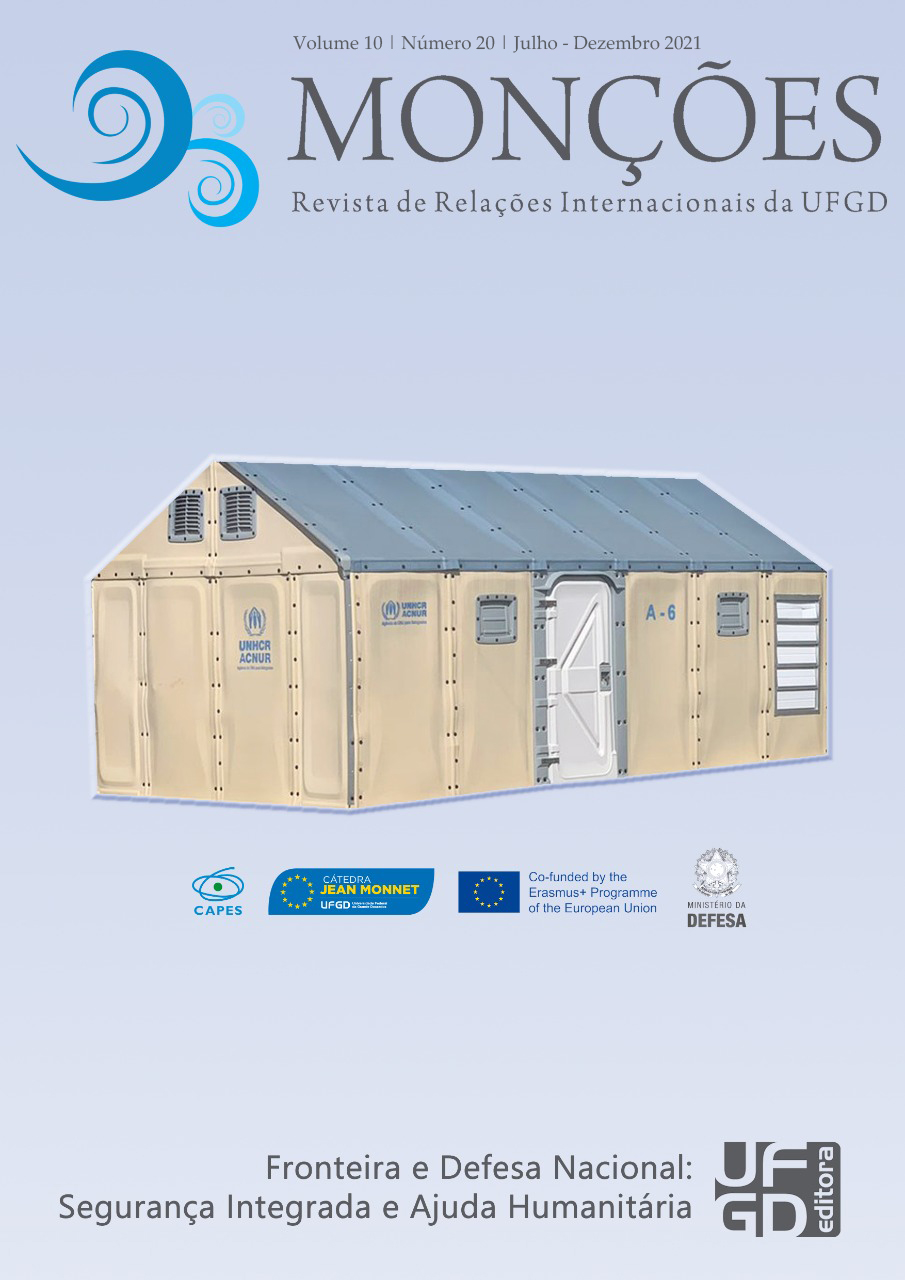Estados Unidos e a política de controle de fronteiras: práticas de militarização e mecanismos de vigilância com o México no pós-11 de setembro
DOI:
https://doi.org/10.30612/rmufgd.v10i20.13944Keywords:
Militarização, Fronteira EUA-México, Guerra ao TerrorAbstract
A chegada de Donald Trump à presidência dos EUA reanimou debates sobre a gestão das fronteiras do país, principalmente com o México. A partir de um estudo qualitativo, com uma revisão bibliográfica, o artigo demonstra que, apesar da mudança de tom, os governos anteriores de George W. Bush e de Barack Obama já imprimiam um caráter de contínua militarização deste espaço, com a constituição discursiva de "ameaças externas" e o emprego de dispositivos materiais translados dos conflitos armados. O artigo faz uma análise qualitativa da fronteira EUA-Mèxico para materializar tais pontos e questões.
Downloads
References
ANDREAS, P. (2003). Redrawing the line: Borders and security in the twenty-first century. International security, 28(2), 78-111.
ANDREAS, P. (2009) Border Games: Policing the US–Mexico Divide , 2nd edn, Ithaca, NY: Cornell University Press.
BRANCOLI, F. L (2016). Companhias Antropofágicas de Segurança no Sul Global: narrativas de privatização da violência e construção de ameaças na Líbia e no Afeganistão.
BENEDETTI, A. (2014). Espacios fronterizos del sur sudamericano: Propuesta de un modelo conceptual para su estudio. Estudios fronterizos, 15(29), 11-47.
BRUBAKER, R. (2002) ‘Ethnicity without groups,’ European Journal of Sociology , 43: 163 89.
BRUNET-JAILLY, E. (2005). Theorizing borders: An interdisciplinary perspective. Geopolitics, 10(4), 633-649.
BUSH, George W. (2001) "Address to the Nation." Speech. Bush 2001h. Washington, DC. Presidentialrhetoric.com. 20 Sept. 2001. Acesso em abril de 2020 <http://www.presidentialrhetoric.com/speeches/09.20.01.html>.
BUSH, George W. (2002). National Security Strategy of the United States , georgewbush whitehouse.archives.gov/nsc/nss/2002/
COLEMAN, M. (2007) ‘A geopolitics of engagement: neoliberalism, the war on terrorism, and the reconfiguration of US immigration enforcement,’ Geopolitics , 12(4): 607–34.
GOLASH-BOZA, T. (2018). 2. President Obama’s Legacy as “Deporter in Chief”. In Immigration Policy in the Age of Punishment (pp. 37-56). Columbia University Press.
GOMES, S., & ACACIO, I. D. P. (2015). United (Mexican) States and the spiral of violence: for a brief critique of the notion of" Failed State"/Estados Unidos (Mexicanos) e a espiral de violência: uma breve critica a noção de" Estado Falido". Mural Internacional, 6(2), 278-293.
HADDAL, C., Y. Kim and M. Garcia (2009) Border Security: Barriers along the US International Border , Washington, DC: Congressional Research Services.
HASELSBERGER, B. (2014): Decoding borders. Appreciating border impacts on space and people, Planning Theory & Practice.
HERNÁNDEZ, K. L. (2010). Migra!: A history of the US border patrol (Vol. 29). Univ of California Press.
HEYMAN, J. E J. ACKELSON (2009) ‘United States border security after 9/11,’ in J. Winterdyk and K. Sundberg (eds), Border Security in the al-Qaeda Era , New York: CRC Press, pp. 37–75.
HUNTINGTON, S. (2009). The hispanic challenge. Foreing Policy. Disponível em: https://foreignpolicy.com/2009/10/28/the-hispanic-challenge/ Acesso em 9 de junho de 2021.
KAISER, R. (2002) ‘Homeland making and the territorialization of national identity,’ in D. Conversi (ed.), Ethnonationalism in the Contemporary World: Walker Connor and the Study of Nationalism , New York: Routledge, pp. 229–47.
KOLOSOV, V. A. (2015). Theoretical approaches in the study of borders. Introduction to Border Studies. Vladivostok: Dalnauka, 33-62.
KNOWLTON, B. (2001) ‘Americans back Bush’s ultimatum to Taleban; 91% support President, poll on speech shows,’ International Herald Tribune , 21 Setembro, p. 1.
MURPHY, A. (1996) ‘The sovereign state system as political-territorial ideal: historical and contemporary considerations,’ in T. Biersteker and C. Weber (eds), State Sovereignty as Social Construct , Cambridge: Cambridge University Press, pp. 81–120.
NEW YORK TIMES (2005) ‘Governors say they will raze border town used by smugglers,’ 28 Agosto. A19.
PAASI, A. (2005). Generations and the ‘development’ of border studies. Geopolitics, 10(4), 663-671.
ROSIÈRE, S. and R. Jones (2012) ‘Teichopolitics: reconsidering globalization through the role of walls and fences,’ Geopolitics , 17: 217–34.
SACK, R. (1986) Human Territoriality: Its Theory and Practice , Cambridge: Cambridge University Press.
SZARY, A. L. A., & GIRAUT, F. (2015). Borderities: The politics of contemporary mobile borders. In Borderities and the politics of contemporary mobile borders (pp. 1-19). Palgrave Macmillan, London.
SCOTT (2009) The Art of Not Being Governed: An Anarchist History of Upland Southeast Asia , New Haven, CT: Yale University Press.
THOMPSON, G. (2005a) ‘In lawless town, the top lawman avoids trouble,’ New York Times , 20 Agosto, p. A4.
WIENER, M. (2002) ‘Mexican drug lord’s arrest helps Fox as he awaits Bush,’ New York Times , 11 Março. A3.
Downloads
Published
How to Cite
Issue
Section
License
- Os autores e autoras mantêm os direitos autorais e concedem à revista o direito de primeira publicação, com o trabalho simultaneamente licenciado sob a Creative Commons Atribuição-NãoComercial-CompartilhaIgual 3.0 Brasil. que permite o compartilhamento do trabalho com reconhecimento da autoria e publicação inicial nesta revista.
- Autores e autoras têm autorização para assumir contratos adicionais separadamente, para distribuição não-exclusiva da versão do trabalho publicada nesta revista (ex.: publicar em repositório institucional ou como capítulo de livro), com reconhecimento de autoria e publicação inicial nesta revista.
- Autores e autoras têm permissão e são estimulados a publicar e distribuir seu trabalho online (ex.: em repositórios institucionais ou na sua página pessoal) a qualquer ponto antes ou durante o processo editorial, já que isso pode gerar alterações produtivas, bem como aumentar o impacto e a citação do trabalho publicado, porém invariavelmente com o reconhecimento de autoria e publicação inicial nesta revista.


